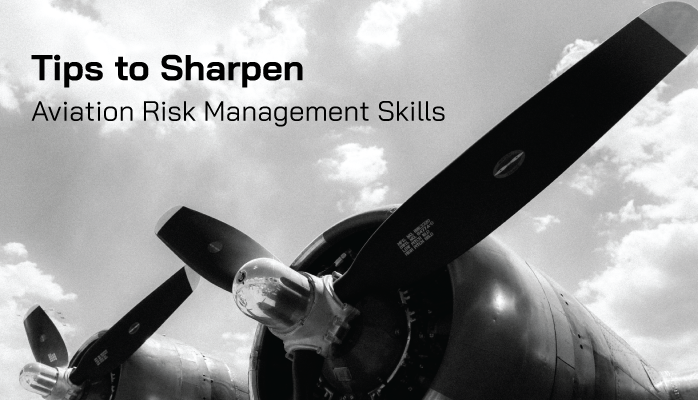Aviation Risk Management Skills Always Need Refining

Pilots have to be committed to safety.
At the end of the day, safety is the most important thing in aviation.
Whenever aviation service providers take risks with safety, they are possibly risking their own lives and the lives of others.
An aviation professional who is successful in risk management is a person who is:
- detail oriented;
- excellent at prioritizing;
- focused on continuing to sharpen skills;
- interested in learning new risk management tools; and
- staying current with rules, techniques, and practices within their field.
Related Aviation Risk Management Articles
- Difference Between Reactive, Predictive and Proactive Risk Management in Aviation SMS
- 3 Main Components of Aviation Risk Management
- What Is the Process of Risk Management in Aviation SMS
Tiny Details May Indicate Significant Risk Factors
In aviation risk management processes, details matter. For example, a pilot can’t skim over a checklist and just assume they have completed it. He or she needs to be sure they have looked at and verified each step, even if they have completed the same checklist ten thousand times.
Each step is essential and there for a reason. Forgetting one tiny thing can have tragic consequences.
I believe every pilot knows this, but it’s easy to become lazy or complacent. Someone who is successful in risk management activities will overcome the temptation to skim through and focus on each detail, realizing that each checklist item was added to the checklist for a particular reason. The reason the item is on the checklist is not really important to the "inspector."
If a pilot is performing a pre-flight check and
- something small is missing or
- if there’s a strange sound or odd smell or
- something is just “off”
– these details, no matter how small, can’t be ignored. Each piece is important to the puzzle and worth taking the time to fix and investigate.
Thinking “it’s probably fine” is a dangerous conclusion.
Complex Operations Increase Need for Safety Risk Management
A lot going on in a typical aviation operation, even from a single actor's perspective, such as the pilot's. A pilot has many things to do and consider in the course of a flight. While all "individual risk factors" are significant, some need to take priority over others.
Someone successful in aviation risk management processes knows how to properly prioritize risk factors so that safety remains paramount.
Being able to shift focus is also critical. For instance, a pilot can’t be so consumed with dialing in a navigation frequency that they ignore a call from ATC. A student pilot practicing ground reference maneuvers can’t be so focused on what they are about to do that they forget to clear turns and check the area for traffic beforehand.
A pilot must be able to prioritize and shift their focus throughout the flight to make sure that things are done safely and properly.
Related Aviation Risk Management Articles
- 4 Elements of Safety Risk Management (SRM)
- How to Practice Reactive, Proactive, and Predictive Risk Management in Aviation SMS
- From Reactive to Proactive Risk Management in Aviation SMS
Successful Risk Managers Continue to Learn
A person who excels in aviation risk management never stops honing their skills. Whether they are attending SMS training courses or acquiring another rating, these self-motivated learners are actively seeking to take their skills to the next level.
Learning and practicing new skills shouldn’t stop after a person passes their check ride. A successful and safe pilot is always using and continuing their training. These proactive pilots are actively searching out new information from a wide variety of sources, such as
- safety newsletters,
- accident investigations;
- industry journals and
- lessons learned libraries.
Complacency Becomes Recipe for Disaster

Becoming complacent and overly confident can be a recipe for disaster. A seasoned pilot who is successful in risk management will remember that anything can happen and stay prepared. Practicing emergency procedures, even though they may be rarely used, is important for keeping skills sharp.
Policies and procedures change as well, so keeping up with current rules and practices is also essential.
Complacency is simply one of the human factors.
Experienced, proactive pilots are familiar with how human factors affect operational safety in various parts of the organization and the effects of these influences on other "actors" in the "system" for which they interoperate. In short, while we may recognize our limitations and how human factors shape our own personal behavior and judgment, an experienced, and successful risk management practitioner is more aware of how these human factors influence the behaviors of employees that are part of the "operational process."
These most recognizable human factors in aviation are among the "Dirty Dozen." According to Skybrary, the "Dirty Dozen refers to twelve of the most common human error preconditions or conditions that can act as precursors, to accidents or incidents." These human factors include:
- Lack of communication;
- Distraction;
- Pressure;
- Stress;
- Fatigue;
- Lack of awareness; and
- Complacency.
Related Articles on Human Factors in Aviation
- Let’s Talk Human Factors - Origin of Dirty Dozen
- Human Factors: Lack of Teamwork
- 5 Things to Know About Aviation SMS Human Factors
Preparation Cannot Be Overstated in Aviation Industry
A prepared pilot is much more likely to handle a situation safely and smoothly than one who is not. That might sound like common sense, but it’s worth reiterating. Even something as seemingly mundane as the traffic pattern should be periodically worked on to maintain high standards of safety and proficiency, whether a person has been flying for 2 months or 2 decades.
Successful aviation risk management practitioners are those who are focused and committed to doing things properly and using what they have learned in their training.
These people do not rush through things or take shortcuts.
They do not think they are immune from mistakes or emergencies.
They take their role in aviation seriously and adhere to the rules and safety procedures in place to ensure that they can continue flying for many years to come.
Safety managers learn from what others are doing at other companies. Here is a great checklist for the routine duties of aviation safety managers. Learn what safety managers do:
- Daily;
- Weekly;
- Monthly;
- Annually...
If your company has difficulty in easily managing safety risk management requirements, it is highly probable that you lack aviation SMS tools to make your jobs easier and to ensure regulatory compliance. Here are some short videos explaining an effective, user-friendly suite of tools to manage safety in the aviation industry.
Last updated in March 2025.







